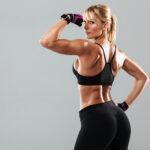Conventional Deadlift: Exercise Overview
The conventional deadlift is a premier compound exercise renowned for its ability to build total-body strength, making it a favorite among bodybuilders, powerlifters, and CrossFit athletes. This movement involves lifting a barbell from the floor to hip level without momentum, emphasizing a controlled hip-hinge pattern.
As one of the “big three” lifts in powerlifting (alongside squats and bench press), the deadlift is a key indicator of strength. Bodybuilders use it to develop the posterior chain, while athletes leverage it for enhanced power and performance. It primarily targets the hamstrings, glutes, and lower back, with significant activation of the lats, traps, core, and forearms for stability and grip (Escamilla et al., 2002). The conventional deadlift requires technical precision, but its hip-hinge pattern is essential for functional fitness. Variations and grip adjustments make it accessible to diverse lifters, fitting seamlessly into lower-body, posterior chain, or full-body workouts (Schoenfeld, 2010).
Variations:
- Romanian Deadlift
- Sumo Deadlift
- Dumbbell Deadlift
- Smith Machine Deadlift
Grip Variations:
- Double Overhand Grip
- Mixed Grip
- Hook Grip
How to Perform the Conventional Deadlift
- Position the barbell over the tops of your shoelaces and stand with feet hip-width apart.
- Hinge at your hips, pushing them back with a moderate knee bend, until your torso is nearly parallel to the floor, keeping your spine neutral.
- Grip the bar with a shoulder-width double overhand grip, wrapping your thumbs around it for security—this is your starting position.
- Inhale deeply, engage your lats (imagine squeezing oranges in your armpits), and slightly lift the bar to “pull the slack out,” ensuring your armpits are over the bar.
- Drive through your entire foot (big toe, little toe, heel) to extend your hips and knees, lifting the bar in a straight line until you’re standing tall.
- Pause briefly at the top with hips locked out, then reverse the movement by hinging at the hips and lowering the bar to the floor with control.
- Reset your position and repeat for the desired number of repetitions.
Tips for Optimal Performance
- Keep the Bar Close: Ensure the bar travels vertically along your legs by engaging your lats, reducing lower-back strain and improving efficiency (McGill, 2010).
- Emphasize Hip Hinge: Avoid squatting the weight up; keep hips higher than in a squat to target the posterior chain effectively (Escamilla et al., 2002).
- Maintain a Neutral Spine: Brace your core to prevent rounding or over-arching your back, protecting your spine and maximizing muscle engagement.
- Adjust Neck Position: Experiment with a neutral neck (chin tucked) or slightly upward gaze based on your posture—those with extended postures may prefer a tucked chin, while those with upper-back flexion may benefit from looking slightly up (Wirth et al., 2016).
- Grip Tightly: Squeeze the bar firmly with a full grip to enhance stability and avoid a thumbless grip, which can reduce control.
- Drive Through Whole Foot: Maintain three points of contact (big toe, little toe, heel) to engage quads and posterior chain effectively, avoiding excessive heel focus.
- Control the Descent: Lower the bar slowly for multiple reps to minimize stress on spinal erectors and increase muscle activation (Schoenfeld, 2016).
- Breathe Properly: Inhale before lifting and exhale at the top to support core stability and muscle oxygenation.
Powering up with deadlifts? Learn how they target multiple muscle groups in our Ultimate Guide to Muscle Groups.







